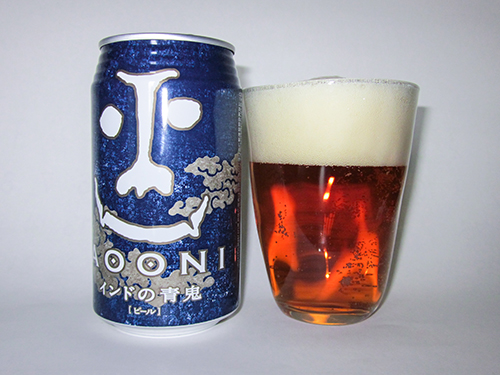174. The "Blue" Radical: 青
The "blue" radical 青 looks identical to this autonomous character:
青 (43: blue, green; youth; pale)
Just as this kanji carries the Joyo kun-yomi あお, the Japanese refer to radical 174 as あお or あおへん (when the radical occupies the left side of a character). And just as 青 primarily means "blue" while also representing "green," English speakers call 青 the "blue" radical, with "green" as an alternate name.
This radical is on duty in just two Joyo kanji, 青 itself and the following character:
静 (519: quiet, calm; motionless)
That's where あおへん comes into the picture.
The eight-stroke radical has a variant, the eight-stroke 靑 (in which 円 is on the bottom instead of 月). That's the non-Joyo version of the 青 character, whereas 靜 is the old shape of 静.

Photo Credit: Samuel
A blue beer can with a smiley face?! I'm glad this product is so friendly because its name could seem threatening; the beer is called インドの青鬼 (インドのあおおに), literally, "Indian Blue Devil." What a relief that the beer is not blue in the least.
By the way, 青鬼 combines two radicals!
Etymologies
To see what 青 symbolizes, I consulted Henshall's newer edition, the source of all etymological information in this Radical Note. Here's what that source says:
青 (43: blue, green; youth; pale)
The lower part represents a "well dug for the excavation of cinnabar," and the upper half is thought to be a variant of 生. This phonetic contributes sound and possibly meaning—namely, "the green of young plants." As to how "cinnabar" relates to the definitions of 青, Henshall cites one scholar who says that cinnabar can be blue or green.
Let me connect the dots a bit more. The bottom half of 青 is 月, which resembles 丹. That autonomous kanji primarily means "red earth (i.e., containing cinnabar or red lead)" and secondarily represents "vermilion," the main color of the mineral cinnabar.
By the way, as essay 1563 on 丹 shows, 丹 combines with 青 in 丹青 (たんせい or たんぜい: (1) red and blue; (2) paints; colors; (3) painting; picture). That's inconsequential in our exploration of the 青 radical—just a bit of fun!
Here's Henshall's take on 静:
静 (519: quiet, calm; motionless)
Sources disagree about the radical of 静. In one view, 青 (green/blue) is the radical, and 争 phonetically conveys the associated sense "beautiful," yielding "beautiful green/blue color" as the overall meaning, with "quiet, calm" as loan usage. From another perspective, 争 is the radical, with 青 phonetically providing the associated sense "stop." Together they produce "stop conflict" as the meaning of 静, which came to mean "quiet, calm."
According to some dictionaries, then, 青 may be the only Joyo kanji featuring the on-duty 青 radical.
Photo Credit: Eve Kushner
Another nonthreatening blue devil! As I explain in essay 1128 on 鬼 (devil), this blue devil (青鬼, あおおに) is the friendly (親切, しんせつ) mascot of Kagawa Prefecture on Shikoku. The large hiragana, わがかがわ, are a way of writing 我が香川 (our Kagawa). Why the hiragana? Well, they form a palindrome!
This blue devil comes from the rather famous children’s story「泣いた赤鬼 (ないたあかおに)」, The Red Devil Who Cried. See essay 1128 for that tale!
